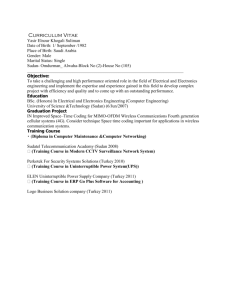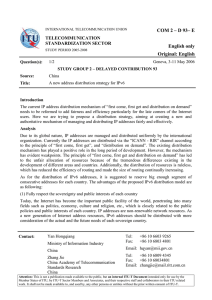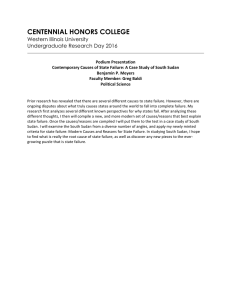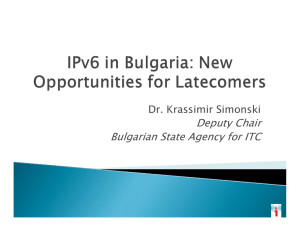Eng. Sami H. O. Salih President of SDv6TF
advertisement
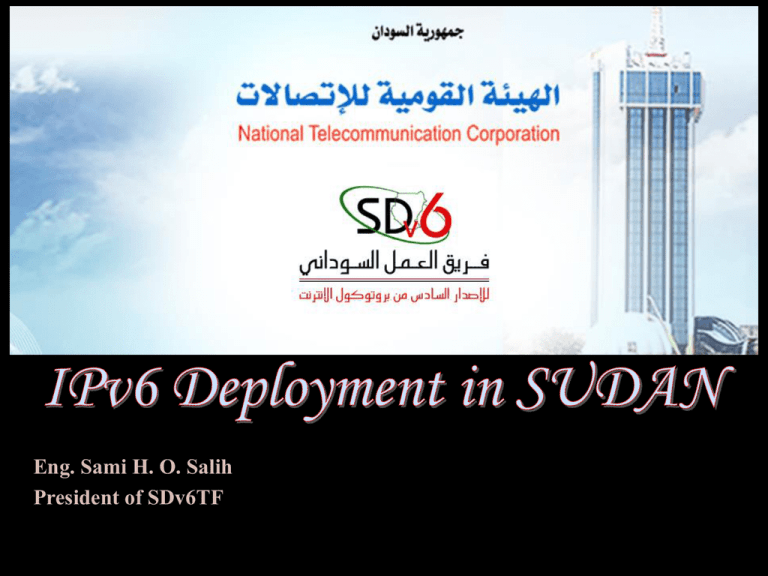
Eng. Sami H. O. Salih President of SDv6TF Contents Part (I) About Sudan; Part (II) Telecommunication Sector Overview; Part (III) Telecom Sector Assessment; About Sudan One Million Square Miles, 8.5% of the land area of Africa, 25 Stat. Population: 39.1 million (2008) Telecommunications Progress 1859 – Telecommunications introduced in Sudan (1st telegraph link between Cairo & Sawaken), 1871–1873 Telegraph line reached Khartoum (Small unit for Post & Telegraph). 1892/1903 – First Telephone exchange in Sudan (Eldaba & Khartoum). 1910 -1971 – The service was run by a government body known as Posts & Telegraphs (P&T) 1971- 1978 Telecommunication was separated from the Post service and run as a governmental Department. 1978 – 93 Sudan Telecommunications Public Corp, (STPC). Telecommunications Progress (Cont …) 1993 – 94 Privatization of Telecommunication Sector. 1994-2001 National Telecommunication Council 2001, National Telecomm. Corporation (NTC) formed under Telecommunication Act 2001. 1994, Sudan Telecom Co. (SUDATEL) started as an Operator & Service provider. 1997, license issued to a cellular service provider Sudanese Mobile Telephone Co. (MOBITEL). 1997, First ISP, Sudanese Internet Service Co. (Sudanet). 2001, First Pre-paid service, Ashraaf International (Ashraaf com). 2003, license issued to the second mobile operator (Areeba). 2005, license issued to the second fixed operator (Canar). 2006, Sudatel launch its 3G - UMTS Network (Sudani). Internet progress 1996, Internet was introduced in Sudan by the Sudan Internet Services Co. Ltd. [Sudanet] with 128Kbps Bandwidth capacity. In early 1998, the Sudan Telecom Co. Ltd. [Sudatel] introduced its Internet Service in the country as a value added service to its basic fixed telephony services with 265Kbps Bandwidth capacity. In Nov 1999, Sudatel became the only pop in Sudan with 2Mbps from EMIX. Sudatel opened its Internet service provisioning to other potential service providers, the enterprise and universities sectors using its existing data communication infrastructure. Legislation Maturity 1974, Telecommunications Law. 2000, National Telecom Corporation Bill National Telecom Council Bill 1994 Telecom Act. 1974 2002, A new Telecom. National Telecommunication Corporation (NTC) http://ntc.gov.sd NTC Objectives Promote and regulate the telecommunication sector so as to conform to development and globalization. Provide the appropriate environment favourable to promotion of telecommunication services and the encouragement of investment in this sector. Ensure and diffuse free competition and recruit competent personnel in the field of telecommunications. Ensure connectivity among licensed telecommunication public networks. Market Structure Coverage: 160 City Coverage: 200 City Technology: GPSR, HSPA Technology: CDMA 1x EV-DO Subscribers: 5903529 Subscribers: 4100000 . موقع بالسودان68/129 :التغطية GSM / UMTS :التقنية 2657639 :عدد المشتركين Coverage: 41 City Technology: WLL CDMA Subscribers: 28083 Total Subscribers: 12689251 Coverage Subscribers Growth Bandwidth and backbone IP addresses Statistics (Source: AfriNIC) IPv6 Deployment Obstacles Current Allocation and Registration Model Hide of the IPv4 Exhaustion Hide of the IPv4 Expansion Techniques Failures (i.e. NAT, CIDR, Dynamic Allocation) Lack of IPv6 Experience Allocation and Registration Model Continue … IP Allocation is not depending on Supply/Demand manner, and obviously it’s not a market for competition. It’s Regulatory trueborn duties, and must distribute fairly regard to the actual demand. The current model work fine, but the global view is to involve ITU and the administration on countries into these processes in order to effectively benefit from their support as well as to keep the administration aware about internet addressing schema. The modifications on the model have made lightly as possible to facilitate what indicates in (3.1.2.) no new entities or procedures just updates on the definitions and insertion of the ITU in the model. Hide of the IPv4 Exhaustion Expansion Techniques Failures Lack of IPv6 Experience Sudan Experience Toward IPv6 Activities 1st IPv6 Workshop; 24June, 2010 As a side event of AREGNET Meeting. Activities 2nd IPv6 Workshop; 1 August, 2010 Publish the Sudanese IPv6 Migration Plan. Form the SDv6TF. Activities 3rd IPv6 Workshop; 1-4 November, 2010 2nd IPv6 Training. Internet Governances day. Activities 4th IPv6 Workshop; 27 October, 2011 Evaluation of the IPv6 Deployment in Sudan on 10 Major Information Network Operator National IPv6 Training Center Achievements in IPv6 Deployment Develop of the National IPv6 Migration Plan (2011-2015) Formation of the SDv6TF (more than 400 member) Organize Three Workshops Collaborate with NAv6 in Continuous Training Program (300 Participant in 2011) Participate on IPv6 Events (ITU, AfriNIC) IPv6 Training Calendar Development in IPv6 Assignment
